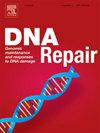核小体核心颗粒中碱基切除修复的全球筛选。
IF 2.7
3区 生物学
Q2 GENETICS & HEREDITY
引用次数: 0
摘要
DNA 损伤是导致基因组不稳定的根本分子原因。碱基切除修复(BER)是将受损核碱基病变的潜在突变性和/或毒性降至最低的一道防线。然而,人们对染色质中的碱基切除修复尚未完全了解,在染色质中,真核生物基因组 DNA 是通过 DNA 组蛋白相互作用的层次结构压实的。在这里,我们研究了核糖体核心颗粒(NCP)中 27 个独特几何位置的 BER 酶的活性,核糖体核心颗粒是染色质中包装的最小单位。BER酶包括尿嘧啶DNA糖基化酶(UDG)、AP内切酶1(APE1)、DNA聚合酶β(Pol β)和与X射线修复交叉互补组1(LigIIIα/XRCC1)复合的DNA连接酶IIIα。这种对 BER 的全面分析表明,UDG 修复事件的启动是由病变的旋转位置决定的。APE1 在启动修复的位置具有强大的活性,而在核糖体 DNA 中央 ∼45 bp 的 Pol β 核苷酸掺入步骤中,修复活动停滞不前。修复的最后一步由 LigIIIα/XRCC1 催化,只有在 NCP 的入口/出口区域,当缺口位点从组蛋白上解开而瞬时暴露时才能完成。动力学测定进一步阐明,受损病变的位置会调节酶的活性。值得注意的是,这些数据表明,即使没有染色质重塑因子或其他细胞因子,一些 BER 酶也能在许多位置发挥作用。这些结果为 DNA 损伤和突变的全基因组图谱提供了信息,有助于我们了解突变热点和特征。本文章由计算机程序翻译,如有差异,请以英文原文为准。
Global screening of base excision repair in nucleosome core particles
DNA damage is a fundamental molecular cause of genomic instability. Base excision repair (BER) is one line of defense to minimize the potential mutagenicity and/or toxicity derived from damaged nucleobase lesions. However, BER in the context of chromatin, in which eukaryotic genomic DNA is compacted through a hierarchy of DNA-histone protein interactions, is not fully understood. Here, we investigate the activity of BER enzymes at 27 unique geometric locations in a nucleosome core particle (NCP), which is the minimal unit of packaging in chromatin. The BER enzymes include uracil DNA glycosylase (UDG), AP endonuclease 1 (APE1), DNA polymerase β (Pol β), and DNA ligase IIIα complexed with X-ray repair cross complementing group 1 (LigIIIα/XRCC1). This global analysis of BER reveals that initiation of the repair event by UDG is dictated by the rotational position of the lesion. APE1 has robust activity at locations where repair is initiated whereas the repair event stalls at the Pol β nucleotide incorporation step within the central ∼45 bp of nucleosomal DNA. The final step of the repair, catalyzed by LigIIIα/XRCC1, is achieved only in the entry/exit regions of the NCP when nick sites are transiently exposed by unwrapping from the histones. Kinetic assays further elucidate that the location of the damaged lesion modulates enzymatic activity. Notably, these data indicate that some of the BER enzymes can act at a significant number of locations even in the absence of chromatin remodelers or other cellular factors. These results inform genome wide maps of DNA damage and mutations and contribute to our understanding of mutational hotspots and signatures.
求助全文
通过发布文献求助,成功后即可免费获取论文全文。
去求助
来源期刊

DNA Repair
生物-毒理学
CiteScore
7.60
自引率
5.30%
发文量
91
审稿时长
59 days
期刊介绍:
DNA Repair provides a forum for the comprehensive coverage of DNA repair and cellular responses to DNA damage. The journal publishes original observations on genetic, cellular, biochemical, structural and molecular aspects of DNA repair, mutagenesis, cell cycle regulation, apoptosis and other biological responses in cells exposed to genomic insult, as well as their relationship to human disease.
DNA Repair publishes full-length research articles, brief reports on research, and reviews. The journal welcomes articles describing databases, methods and new technologies supporting research on DNA repair and responses to DNA damage. Letters to the Editor, hot topics and classics in DNA repair, historical reflections, book reviews and meeting reports also will be considered for publication.
 求助内容:
求助内容: 应助结果提醒方式:
应助结果提醒方式:


